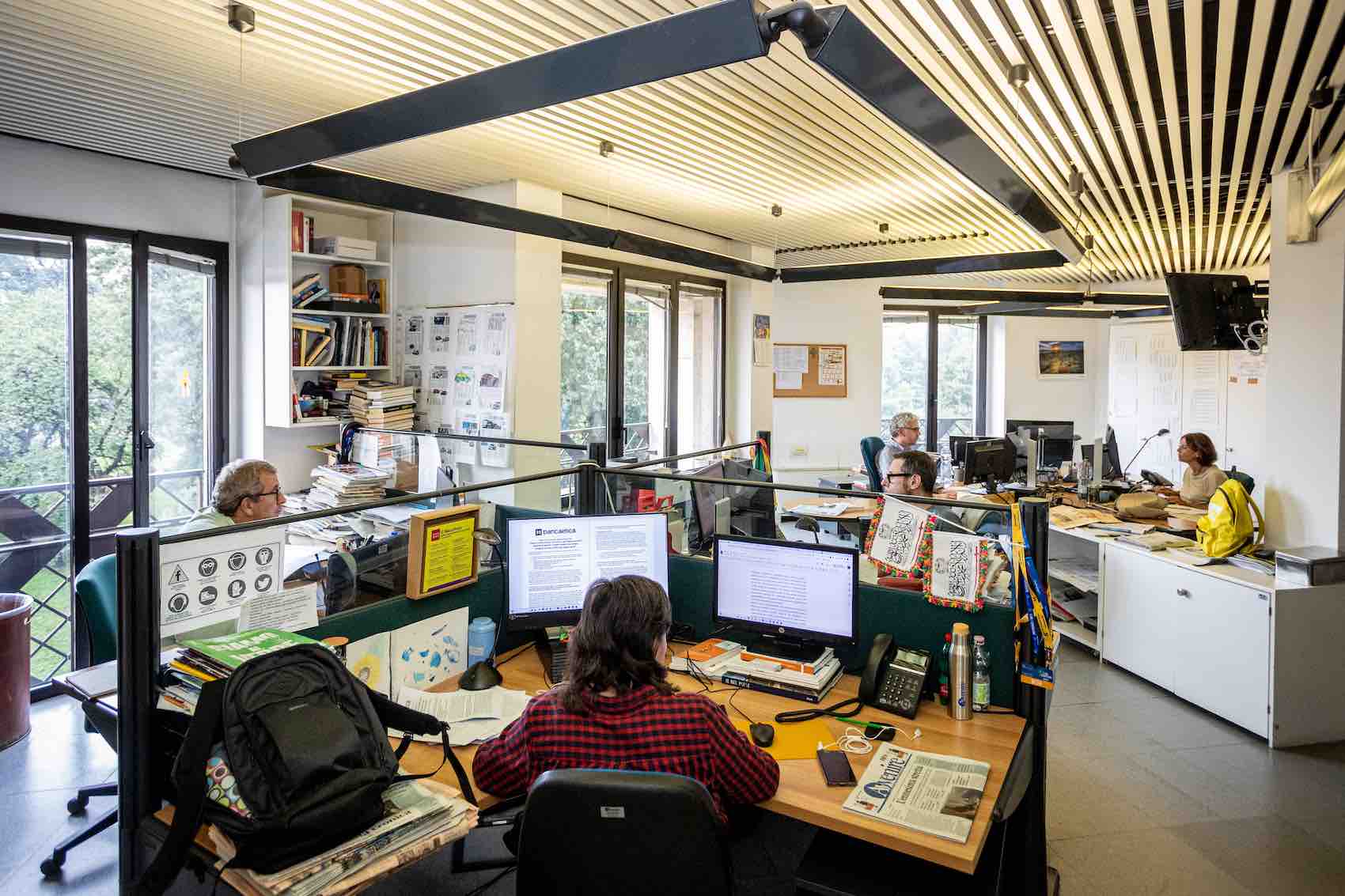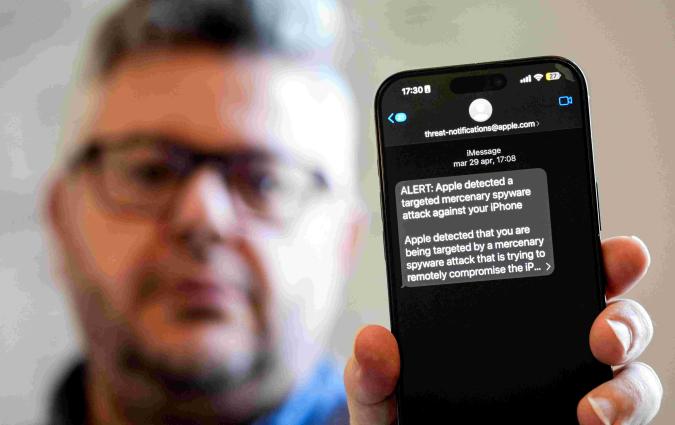How two Catholic newspapers are reinventing themselves to survive in a secular Europe

Journalists at the newsroom of Italian newspaper Avvenire.
The Catholic press moves in mysterious ways.
It can take the form of a local church bulletin, a national broadsheet, or a TikTok account. It can also vary widely in its interpretation of what it means to be Catholic – for instance, it's hard to find common threads between Témoignage Chrétien, the progressive paper founded by priests resisting Nazi occupation, and Poland’s ultra-traditionalist Fronda magazine.
La Croix in France and Avvenire in Italy stand out as the most successful newspapers in Europe’s Catholic media landscape, counting more than 80,000 paying subscribers each across print and digital.
While these numbers don’t rival those of secular counterparts like Le Monde or Corriere della Sera (with over half a million subscribers each), they are among the top five and top six newspapers in their respective countries.
In a world where both traditional news media and organised religion are losing influence, how are these outlets dealing with these twin existential crises? I spoke to two of their top editors to learn more about their current challenges and about their strategy for survival.
Same but different
Like their secular counterparts, both La Croix and Avvenire are first and foremost daily national news outlets focused on current events - though they pay particular attention to religious news, both within Catholic institutions and beyond.
“In our daily 24-page print edition, religious news will fill around three pages, with a focus on Catholic news. But we also pay close attention to current affairs in Islam, Judaism, and Protestantism,” says Jean-Christophe Ploquin, Editor-in-Chief of La Croix.
What makes these papers different is their Catholic perspective on the world, which guides their coverage of secular news. But they struggle with the same challenges as any other legacy media: falling ad revenue, declining print readership, and the rocky transition to a viable digital model. Both La Croix and Avvenire are currently running at a loss and rethinking their business and editorial strategy.
“Like many of our colleagues in the legacy media, we initially thought we could fund our digital offering purely through advertising,” says Ploquin. “But as it's become clear that online ad revenue does not allow for a truly sustainable economic model, we’ve shifted our focus towards digital subscriptions.”
This strategy is paying off - La Croix’s digital subscriber base has more than doubled in the last five years, with over 20,000 subscribers paying for digital-only access.
Marco Ferrando, Managing Editor of Avvenire, mentions similar goals. “Our aim is to leverage the strong legacy we have for our print subscriptions and translate that into our digital product,” he says. Avvenire now counts over 30,000 digital-only subscribers.
Adapting to the audience
La Croix and Avvenire’s precarious transition to digital-first is a challenge they share with the rest of the legacy press. But the faith-based identity of these newspapers presents an additional hurdle: ensuring they stay relevant in an increasingly secular society, where less than half of the population in France and Italy declare themselves to be practising Catholics.
For La Croix, this has meant rethinking its editorial practices in order to invite a wider readership. “We must reach a broader public, not just a public with a very strong Catholic affinity,” Ploquin says. “We work hard to align our journalism with this idea. For instance, we don’t have articles with too many religious references, or pieces that are only understandable to readers who have an in-depth understanding of Catholic codes.”
Ploquin’s team is also thinking about ways to reach a more diverse public within the Catholic community itself. “A full subscription to La Croix currently costs around €460 euros per year,” he says. “So while it's not a luxury product, it's still something you must be able to afford. That’s an aspect that we are looking at closely when thinking about how to grow our audience.”
As part of this growth strategy, the paper has begun offering products at different price points, like a digital-only subscription starting at €64,90 per year and a weekly magazine format from €165 per year. It also publishes international editions in English and Spanish, and has a dedicated francophone African edition – a strategy that makes a lot of sense when you consider the vast majority of Catholics are now found outside Western Europe.
“The Church is not just the clergy”
These financial and demographic changes point towards a wider question for Catholic media today: what can a religious press offer to audiences in the 21st century?
One answer can be found in its specificity. Similarly to trade publications, these outlets are particularly well-placed to hold to account one of the most powerful (and opaque) institutions in the world.
Far from being PR machines for the Church, these papers have often served a traditional watchdog role, using their subject-area expertise to report on conflict, reform and dissent within the institution. And while Avvenire’s primary shareholder is the Italian Catholic Church and La Croix is owned by the Assumptionists (a non-profit congregation within the Church), both stress that they have full editorial independence.

Similarly, although most of both La Croix and Avvenire’s teams of almost 100 journalists each grew up in Catholic families, neither newspaper sees this as a barrier to rigorous reporting. “We consider faith a private matter and do not ask about our journalists' religious beliefs when hiring,” Ploquin says. Or, as La Croix’s Vatican correspondent put it, "[My faith] doesn't stop me from pointing out when messed-up things are happening in the institution I belong to.”
A look at the reporting these papers have done on the Church’s abuse scandals seems to back this up.
For instance, a recent study published in the European Journal of Communication found that the reporting done by La Croix on cases of sexual and spiritual abuse by Catholic priests displayed “a tendency to highlight systemic causes, particularly the role played by the silence of the Church in the perpetuation of violence, while reporting extensively on individual cases.”
For Ploquin, reporting this story was a clear editorial priority. "We really considered this issue to be very important for us to cover rigorously,” he says. “Because in the end, the church is not just the clergy; it is also, and perhaps most importantly, its members – and it is among these members that most victims of abuse are found. So it is entirely coherent for us to pay particular attention to the story and its victims."
“Our job is to meet society where society is”
More broadly, Ploquin and Ferrando emphasise their newspapers’ continued role in offering a meaningful voice in the public debate, both within the Catholic community and for society at large.
“I really feel that all voices matter in public discourse, and we have a role to play by providing an original voice,” Ploquin says. “This is especially true in this period in France and elsewhere, where there is a huge polarisation and a loss of quality and reason within discussions.”
For La Croix and Avvenire, this voice could be defined as a clear moral lens on current affairs, guided by a humanist-Catholic view of the world.
In practice, this means that an intentional editorial focus is placed on issues like migration, homelessness, poverty and climate change. On this last topic, both Ferrando and Ploquin cite Pope Francis’ 2015 encyclical Laudato Si on the moral imperative for climate action as influential in guiding their coverage. Notably, a 2023 Greenpeace Italy report found that Avvenire published the highest number of articles on the climate crisis among Italian newspapers, positioning it as the only national paper in the country deemed to be effectively reporting on the issue.
“Environmental issues were already an important theme in our coverage because we considered it in line with our values of caring for our ‘common home’,” Ferrando says. “But the Pope’s text really reinforced its importance for us as a central moral and political issue.”
Both papers also make a point not to shy away from covering topics that can be contentious for its younger or more progressive readers, like the Church’s position on social issues. This means giving space to different voices – some progressive and others more traditional – on issues like women in the clergy, gay rights, or abortion rights.
“One of the distinguishing features of Avvenire is its commitment to addressing major existential questions, whether about faith or more broadly. Because of this, we often find ourselves engaging with the opinions and sometimes the criticisms of younger generations,” Ferrando explains. “To address this, our editorial method emphasises clarity and listening. This often means explaining the Church's official positions in simple terms to our readers, while also recognising that not every question has a straightforward answer.”
By combining this audience-first editorial approach with an increasingly viable digital model, these newsrooms are finding ways to stay afloat - and even to grow - in a particularly challenging context.
“Our job is to meet society where society is, and today that means shifting our editorial approach from what we might have done in the past,” says Ploquin. “And at the end of the day, spiritual and religious issues remain very relevant to people’s lives, so I believe that our work at La Croix has value.”
In every email we send you'll find original reporting, evidence-based insights, online seminars and readings curated from 100s of sources - all in 5 minutes.
- Twice a week
- More than 20,000 people receive it
- Unsubscribe any time
signup block
In every email we send you'll find original reporting, evidence-based insights, online seminars and readings curated from 100s of sources - all in 5 minutes.
- Twice a week
- More than 20,000 people receive it
- Unsubscribe any time







